Economics Report: Human Resource Economics and Wage Structure Analysis
VerifiedAdded on 2020/05/01
|15
|3595
|126
Report
AI Summary
This report delves into the field of human resource economics, with a specific focus on wage structures and their impact on employee performance and overall economic well-being. The report begins by introducing the significance of employment and wage structures in determining living standards and economic growth. It then examines various wage models, including equitable wage distribution and pay-for-performance, analyzing their advantages and disadvantages. The report explores the concept of efficiency wages, discussing how higher wages can enhance worker loyalty, productivity, and firm efficiency. It also references the backward-bending labor supply curve and provides empirical evidence to support the different wage theories. The report references various literary works and studies to support the analysis of wage structure and its implications on employees and firms. Overall, the report provides a comprehensive overview of wage structure, offering insights into the complexities of human resource economics and its impact on both employees and businesses.
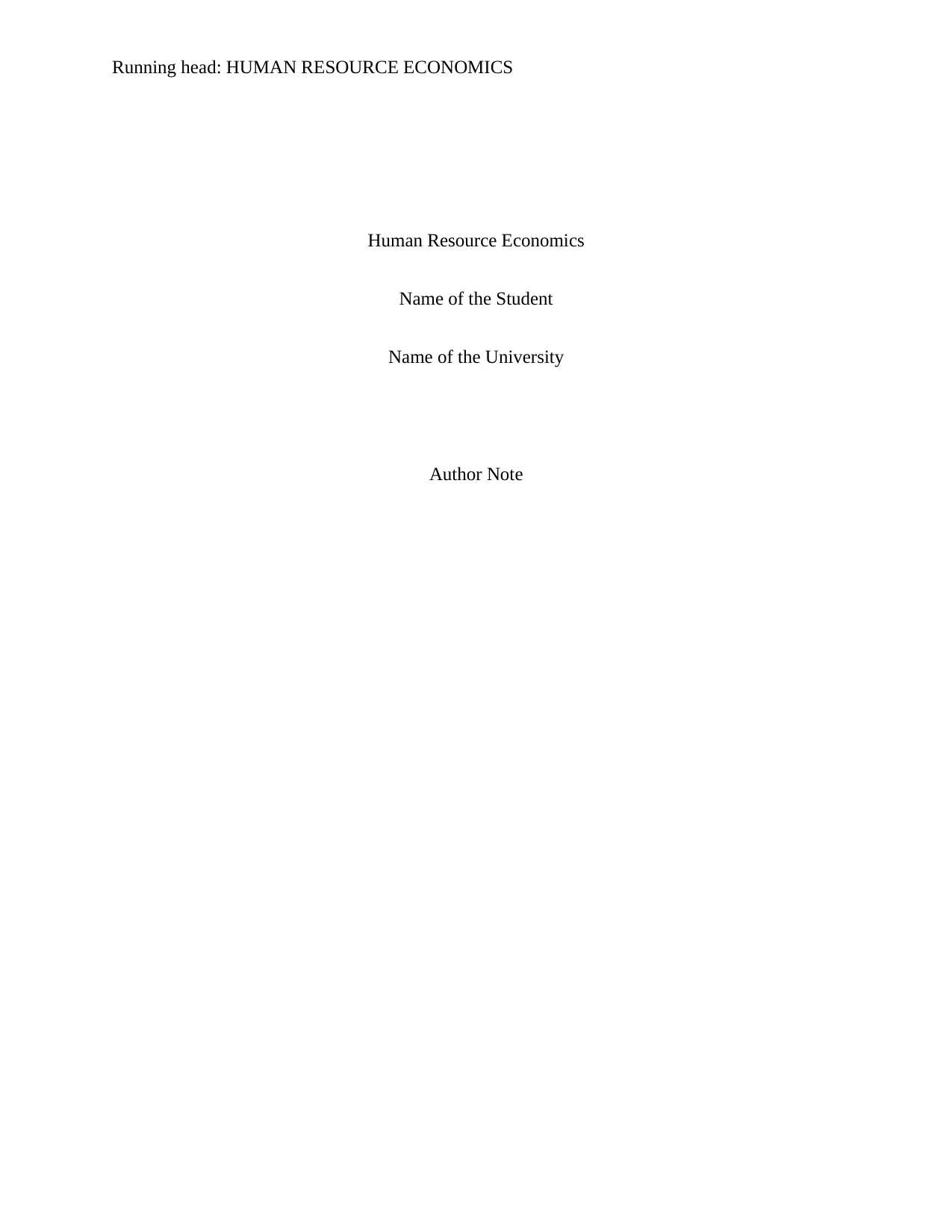
Running head: HUMAN RESOURCE ECONOMICS
Human Resource Economics
Name of the Student
Name of the University
Author Note
Human Resource Economics
Name of the Student
Name of the University
Author Note
Paraphrase This Document
Need a fresh take? Get an instant paraphrase of this document with our AI Paraphraser
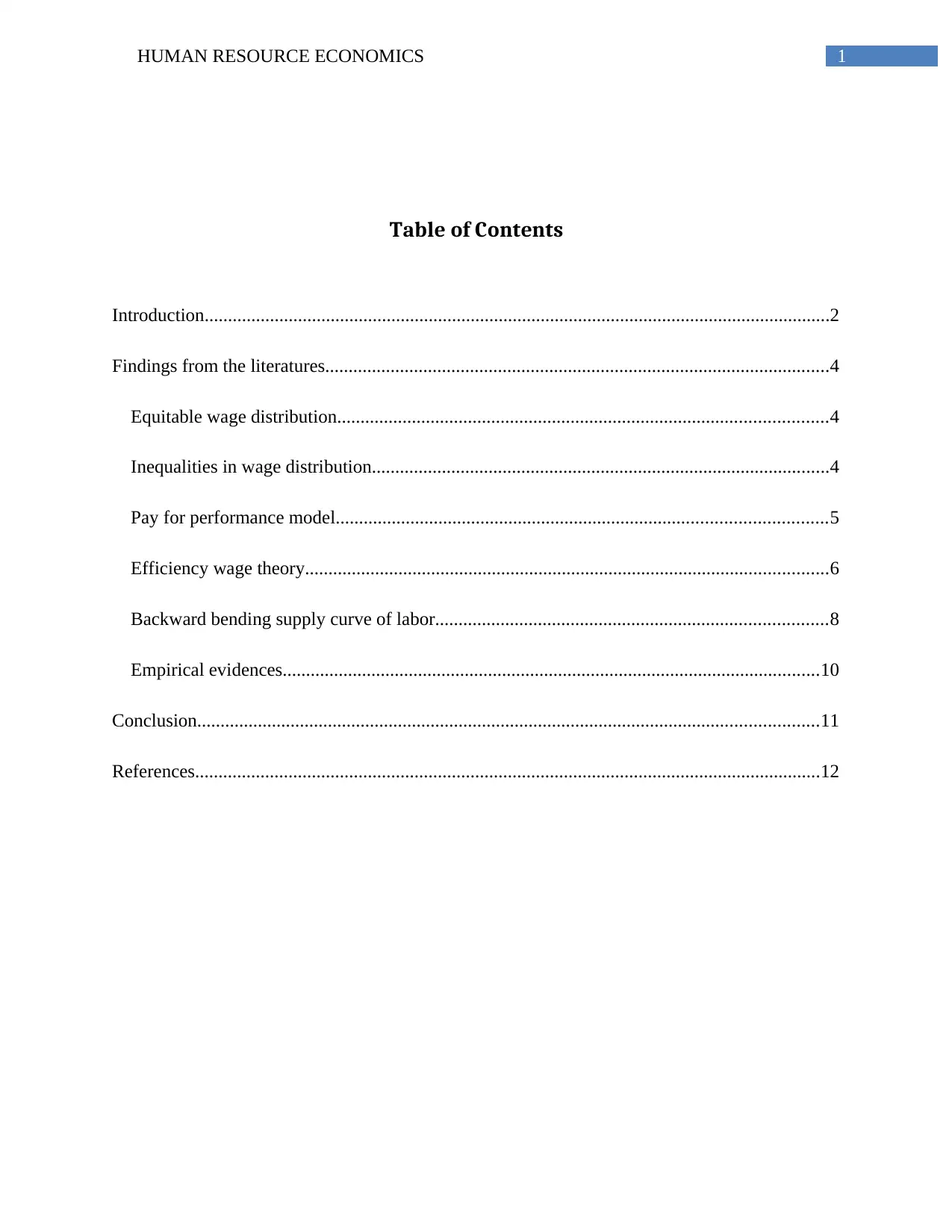
1HUMAN RESOURCE ECONOMICS
Table of Contents
Introduction......................................................................................................................................2
Findings from the literatures............................................................................................................4
Equitable wage distribution.........................................................................................................4
Inequalities in wage distribution..................................................................................................4
Pay for performance model.........................................................................................................5
Efficiency wage theory................................................................................................................6
Backward bending supply curve of labor....................................................................................8
Empirical evidences...................................................................................................................10
Conclusion.....................................................................................................................................11
References......................................................................................................................................12
Table of Contents
Introduction......................................................................................................................................2
Findings from the literatures............................................................................................................4
Equitable wage distribution.........................................................................................................4
Inequalities in wage distribution..................................................................................................4
Pay for performance model.........................................................................................................5
Efficiency wage theory................................................................................................................6
Backward bending supply curve of labor....................................................................................8
Empirical evidences...................................................................................................................10
Conclusion.....................................................................................................................................11
References......................................................................................................................................12
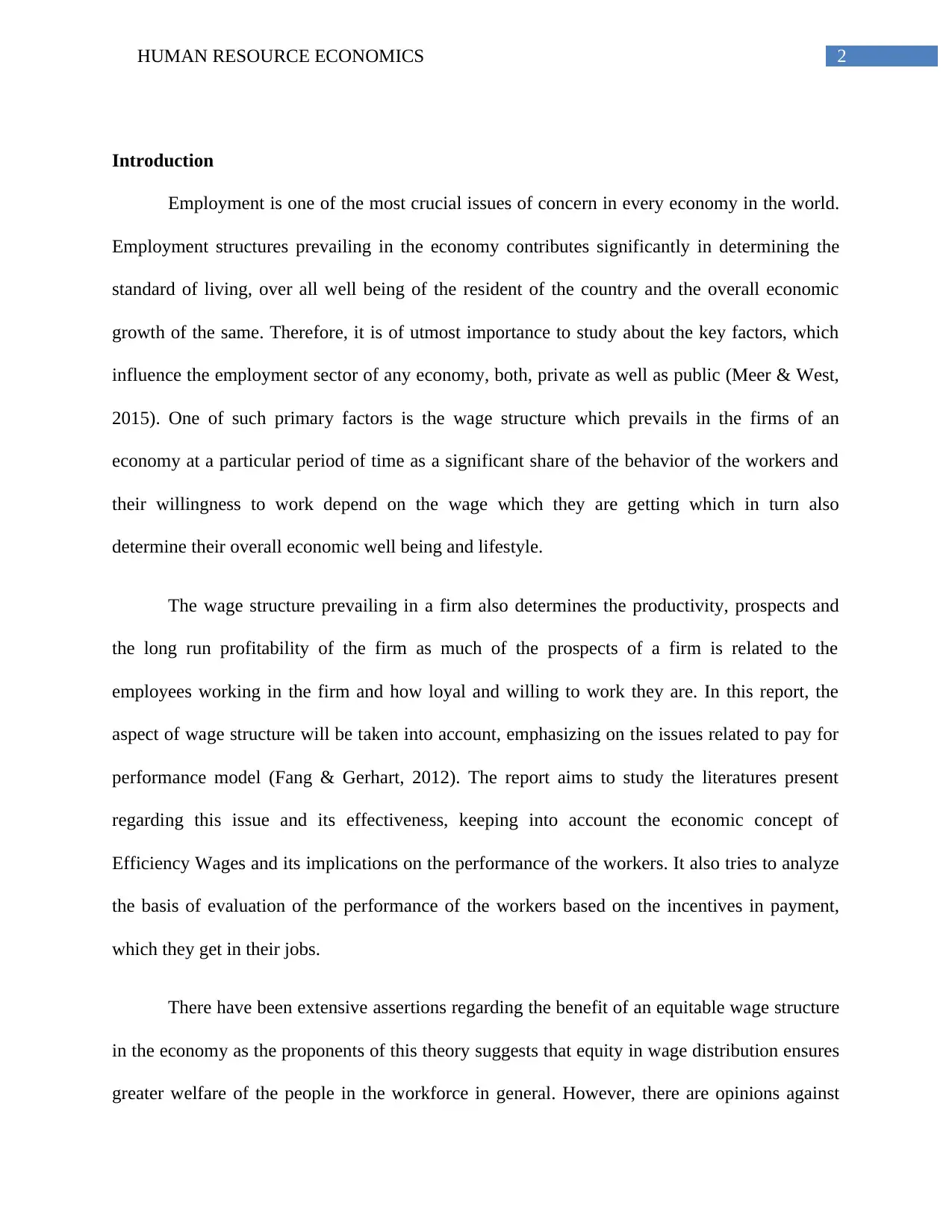
2HUMAN RESOURCE ECONOMICS
Introduction
Employment is one of the most crucial issues of concern in every economy in the world.
Employment structures prevailing in the economy contributes significantly in determining the
standard of living, over all well being of the resident of the country and the overall economic
growth of the same. Therefore, it is of utmost importance to study about the key factors, which
influence the employment sector of any economy, both, private as well as public (Meer & West,
2015). One of such primary factors is the wage structure which prevails in the firms of an
economy at a particular period of time as a significant share of the behavior of the workers and
their willingness to work depend on the wage which they are getting which in turn also
determine their overall economic well being and lifestyle.
The wage structure prevailing in a firm also determines the productivity, prospects and
the long run profitability of the firm as much of the prospects of a firm is related to the
employees working in the firm and how loyal and willing to work they are. In this report, the
aspect of wage structure will be taken into account, emphasizing on the issues related to pay for
performance model (Fang & Gerhart, 2012). The report aims to study the literatures present
regarding this issue and its effectiveness, keeping into account the economic concept of
Efficiency Wages and its implications on the performance of the workers. It also tries to analyze
the basis of evaluation of the performance of the workers based on the incentives in payment,
which they get in their jobs.
There have been extensive assertions regarding the benefit of an equitable wage structure
in the economy as the proponents of this theory suggests that equity in wage distribution ensures
greater welfare of the people in the workforce in general. However, there are opinions against
Introduction
Employment is one of the most crucial issues of concern in every economy in the world.
Employment structures prevailing in the economy contributes significantly in determining the
standard of living, over all well being of the resident of the country and the overall economic
growth of the same. Therefore, it is of utmost importance to study about the key factors, which
influence the employment sector of any economy, both, private as well as public (Meer & West,
2015). One of such primary factors is the wage structure which prevails in the firms of an
economy at a particular period of time as a significant share of the behavior of the workers and
their willingness to work depend on the wage which they are getting which in turn also
determine their overall economic well being and lifestyle.
The wage structure prevailing in a firm also determines the productivity, prospects and
the long run profitability of the firm as much of the prospects of a firm is related to the
employees working in the firm and how loyal and willing to work they are. In this report, the
aspect of wage structure will be taken into account, emphasizing on the issues related to pay for
performance model (Fang & Gerhart, 2012). The report aims to study the literatures present
regarding this issue and its effectiveness, keeping into account the economic concept of
Efficiency Wages and its implications on the performance of the workers. It also tries to analyze
the basis of evaluation of the performance of the workers based on the incentives in payment,
which they get in their jobs.
There have been extensive assertions regarding the benefit of an equitable wage structure
in the economy as the proponents of this theory suggests that equity in wage distribution ensures
greater welfare of the people in the workforce in general. However, there are opinions against
⊘ This is a preview!⊘
Do you want full access?
Subscribe today to unlock all pages.

Trusted by 1+ million students worldwide
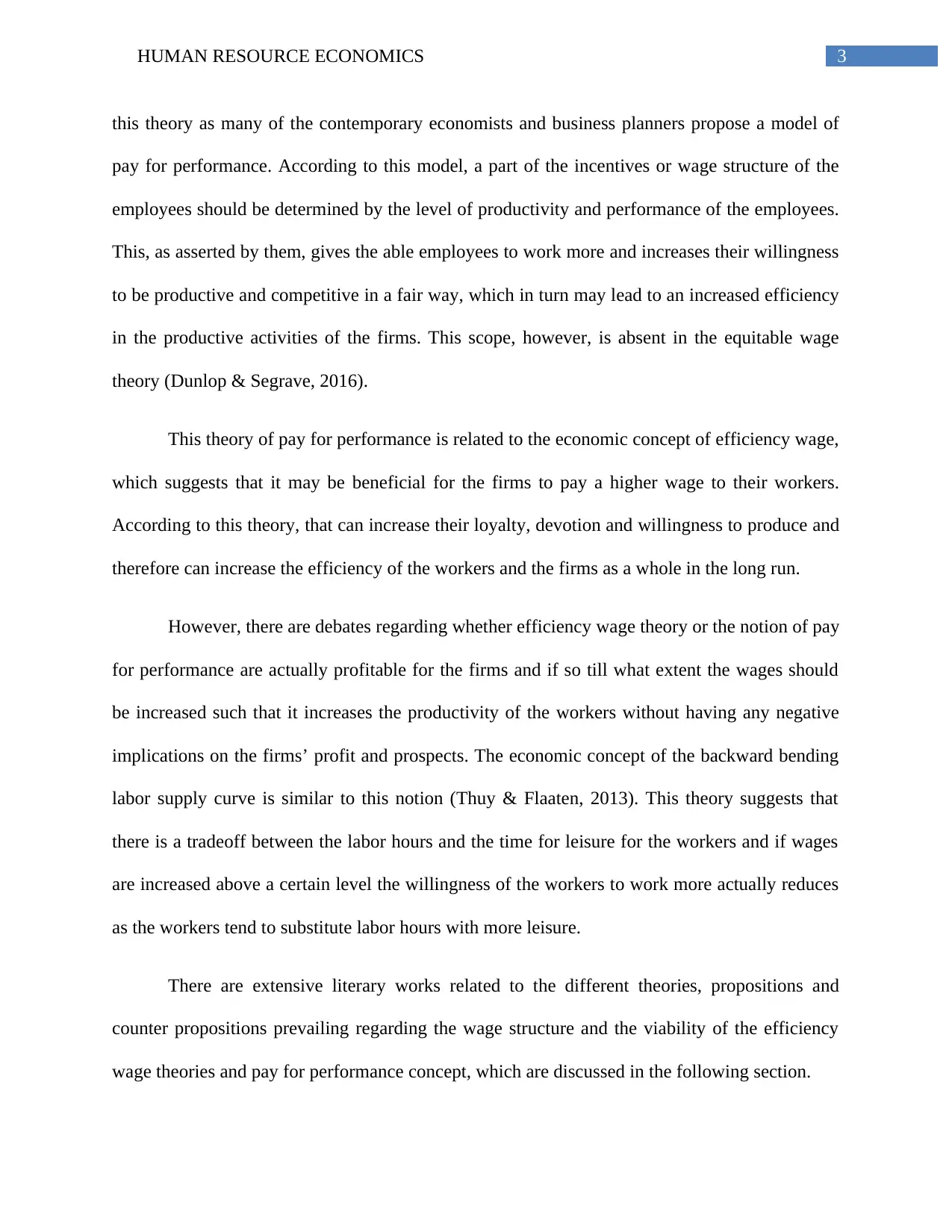
3HUMAN RESOURCE ECONOMICS
this theory as many of the contemporary economists and business planners propose a model of
pay for performance. According to this model, a part of the incentives or wage structure of the
employees should be determined by the level of productivity and performance of the employees.
This, as asserted by them, gives the able employees to work more and increases their willingness
to be productive and competitive in a fair way, which in turn may lead to an increased efficiency
in the productive activities of the firms. This scope, however, is absent in the equitable wage
theory (Dunlop & Segrave, 2016).
This theory of pay for performance is related to the economic concept of efficiency wage,
which suggests that it may be beneficial for the firms to pay a higher wage to their workers.
According to this theory, that can increase their loyalty, devotion and willingness to produce and
therefore can increase the efficiency of the workers and the firms as a whole in the long run.
However, there are debates regarding whether efficiency wage theory or the notion of pay
for performance are actually profitable for the firms and if so till what extent the wages should
be increased such that it increases the productivity of the workers without having any negative
implications on the firms’ profit and prospects. The economic concept of the backward bending
labor supply curve is similar to this notion (Thuy & Flaaten, 2013). This theory suggests that
there is a tradeoff between the labor hours and the time for leisure for the workers and if wages
are increased above a certain level the willingness of the workers to work more actually reduces
as the workers tend to substitute labor hours with more leisure.
There are extensive literary works related to the different theories, propositions and
counter propositions prevailing regarding the wage structure and the viability of the efficiency
wage theories and pay for performance concept, which are discussed in the following section.
this theory as many of the contemporary economists and business planners propose a model of
pay for performance. According to this model, a part of the incentives or wage structure of the
employees should be determined by the level of productivity and performance of the employees.
This, as asserted by them, gives the able employees to work more and increases their willingness
to be productive and competitive in a fair way, which in turn may lead to an increased efficiency
in the productive activities of the firms. This scope, however, is absent in the equitable wage
theory (Dunlop & Segrave, 2016).
This theory of pay for performance is related to the economic concept of efficiency wage,
which suggests that it may be beneficial for the firms to pay a higher wage to their workers.
According to this theory, that can increase their loyalty, devotion and willingness to produce and
therefore can increase the efficiency of the workers and the firms as a whole in the long run.
However, there are debates regarding whether efficiency wage theory or the notion of pay
for performance are actually profitable for the firms and if so till what extent the wages should
be increased such that it increases the productivity of the workers without having any negative
implications on the firms’ profit and prospects. The economic concept of the backward bending
labor supply curve is similar to this notion (Thuy & Flaaten, 2013). This theory suggests that
there is a tradeoff between the labor hours and the time for leisure for the workers and if wages
are increased above a certain level the willingness of the workers to work more actually reduces
as the workers tend to substitute labor hours with more leisure.
There are extensive literary works related to the different theories, propositions and
counter propositions prevailing regarding the wage structure and the viability of the efficiency
wage theories and pay for performance concept, which are discussed in the following section.
Paraphrase This Document
Need a fresh take? Get an instant paraphrase of this document with our AI Paraphraser
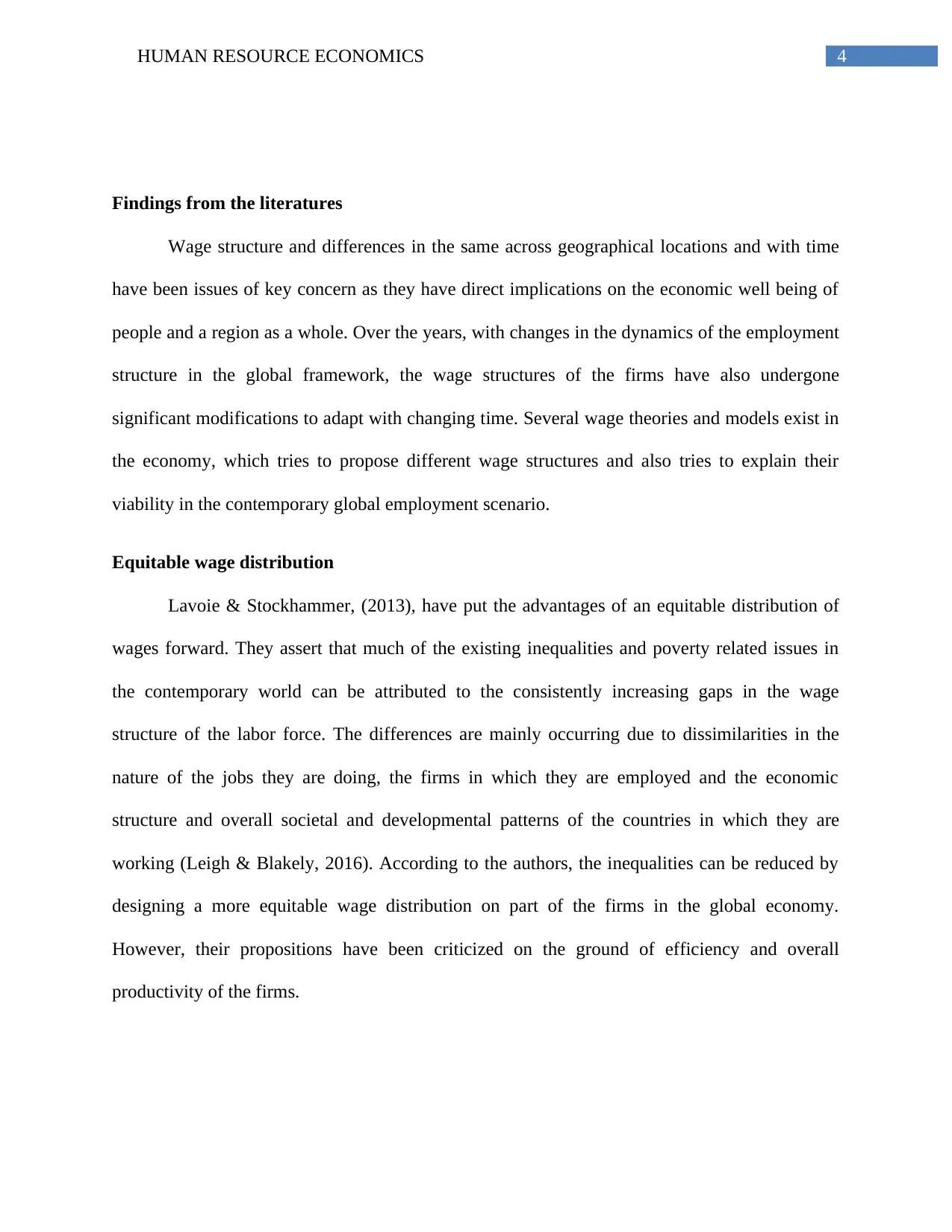
4HUMAN RESOURCE ECONOMICS
Findings from the literatures
Wage structure and differences in the same across geographical locations and with time
have been issues of key concern as they have direct implications on the economic well being of
people and a region as a whole. Over the years, with changes in the dynamics of the employment
structure in the global framework, the wage structures of the firms have also undergone
significant modifications to adapt with changing time. Several wage theories and models exist in
the economy, which tries to propose different wage structures and also tries to explain their
viability in the contemporary global employment scenario.
Equitable wage distribution
Lavoie & Stockhammer, (2013), have put the advantages of an equitable distribution of
wages forward. They assert that much of the existing inequalities and poverty related issues in
the contemporary world can be attributed to the consistently increasing gaps in the wage
structure of the labor force. The differences are mainly occurring due to dissimilarities in the
nature of the jobs they are doing, the firms in which they are employed and the economic
structure and overall societal and developmental patterns of the countries in which they are
working (Leigh & Blakely, 2016). According to the authors, the inequalities can be reduced by
designing a more equitable wage distribution on part of the firms in the global economy.
However, their propositions have been criticized on the ground of efficiency and overall
productivity of the firms.
Findings from the literatures
Wage structure and differences in the same across geographical locations and with time
have been issues of key concern as they have direct implications on the economic well being of
people and a region as a whole. Over the years, with changes in the dynamics of the employment
structure in the global framework, the wage structures of the firms have also undergone
significant modifications to adapt with changing time. Several wage theories and models exist in
the economy, which tries to propose different wage structures and also tries to explain their
viability in the contemporary global employment scenario.
Equitable wage distribution
Lavoie & Stockhammer, (2013), have put the advantages of an equitable distribution of
wages forward. They assert that much of the existing inequalities and poverty related issues in
the contemporary world can be attributed to the consistently increasing gaps in the wage
structure of the labor force. The differences are mainly occurring due to dissimilarities in the
nature of the jobs they are doing, the firms in which they are employed and the economic
structure and overall societal and developmental patterns of the countries in which they are
working (Leigh & Blakely, 2016). According to the authors, the inequalities can be reduced by
designing a more equitable wage distribution on part of the firms in the global economy.
However, their propositions have been criticized on the ground of efficiency and overall
productivity of the firms.
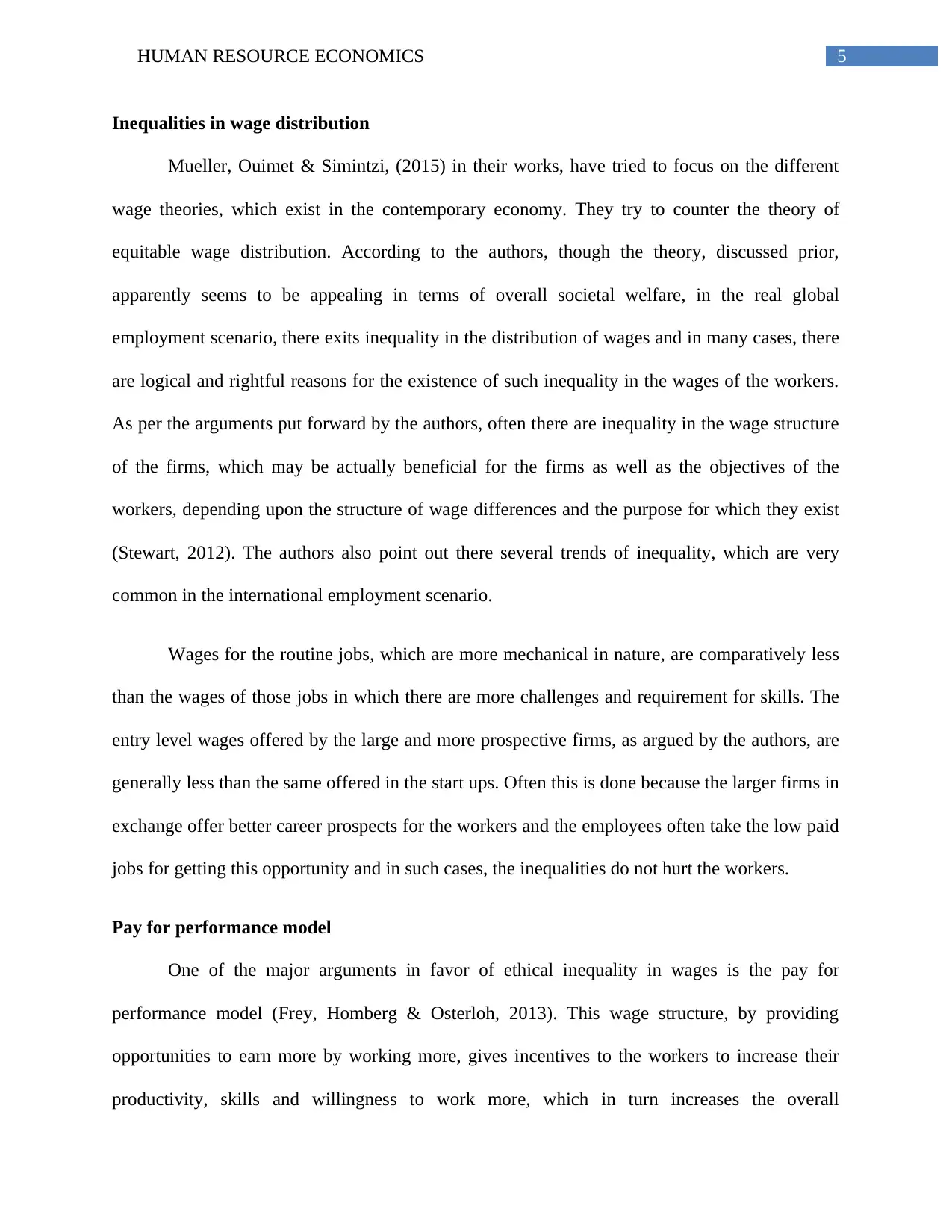
5HUMAN RESOURCE ECONOMICS
Inequalities in wage distribution
Mueller, Ouimet & Simintzi, (2015) in their works, have tried to focus on the different
wage theories, which exist in the contemporary economy. They try to counter the theory of
equitable wage distribution. According to the authors, though the theory, discussed prior,
apparently seems to be appealing in terms of overall societal welfare, in the real global
employment scenario, there exits inequality in the distribution of wages and in many cases, there
are logical and rightful reasons for the existence of such inequality in the wages of the workers.
As per the arguments put forward by the authors, often there are inequality in the wage structure
of the firms, which may be actually beneficial for the firms as well as the objectives of the
workers, depending upon the structure of wage differences and the purpose for which they exist
(Stewart, 2012). The authors also point out there several trends of inequality, which are very
common in the international employment scenario.
Wages for the routine jobs, which are more mechanical in nature, are comparatively less
than the wages of those jobs in which there are more challenges and requirement for skills. The
entry level wages offered by the large and more prospective firms, as argued by the authors, are
generally less than the same offered in the start ups. Often this is done because the larger firms in
exchange offer better career prospects for the workers and the employees often take the low paid
jobs for getting this opportunity and in such cases, the inequalities do not hurt the workers.
Pay for performance model
One of the major arguments in favor of ethical inequality in wages is the pay for
performance model (Frey, Homberg & Osterloh, 2013). This wage structure, by providing
opportunities to earn more by working more, gives incentives to the workers to increase their
productivity, skills and willingness to work more, which in turn increases the overall
Inequalities in wage distribution
Mueller, Ouimet & Simintzi, (2015) in their works, have tried to focus on the different
wage theories, which exist in the contemporary economy. They try to counter the theory of
equitable wage distribution. According to the authors, though the theory, discussed prior,
apparently seems to be appealing in terms of overall societal welfare, in the real global
employment scenario, there exits inequality in the distribution of wages and in many cases, there
are logical and rightful reasons for the existence of such inequality in the wages of the workers.
As per the arguments put forward by the authors, often there are inequality in the wage structure
of the firms, which may be actually beneficial for the firms as well as the objectives of the
workers, depending upon the structure of wage differences and the purpose for which they exist
(Stewart, 2012). The authors also point out there several trends of inequality, which are very
common in the international employment scenario.
Wages for the routine jobs, which are more mechanical in nature, are comparatively less
than the wages of those jobs in which there are more challenges and requirement for skills. The
entry level wages offered by the large and more prospective firms, as argued by the authors, are
generally less than the same offered in the start ups. Often this is done because the larger firms in
exchange offer better career prospects for the workers and the employees often take the low paid
jobs for getting this opportunity and in such cases, the inequalities do not hurt the workers.
Pay for performance model
One of the major arguments in favor of ethical inequality in wages is the pay for
performance model (Frey, Homberg & Osterloh, 2013). This wage structure, by providing
opportunities to earn more by working more, gives incentives to the workers to increase their
productivity, skills and willingness to work more, which in turn increases the overall
⊘ This is a preview!⊘
Do you want full access?
Subscribe today to unlock all pages.

Trusted by 1+ million students worldwide
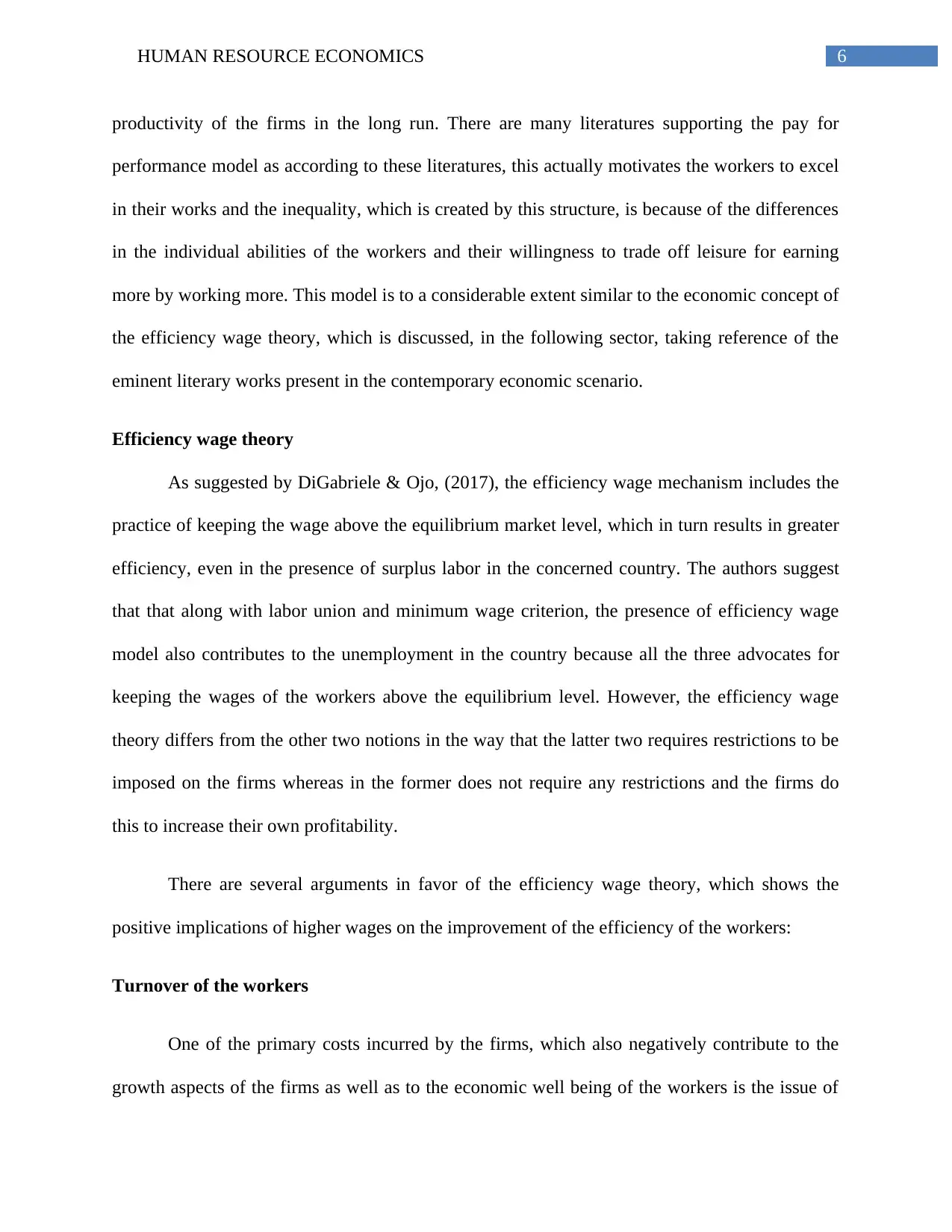
6HUMAN RESOURCE ECONOMICS
productivity of the firms in the long run. There are many literatures supporting the pay for
performance model as according to these literatures, this actually motivates the workers to excel
in their works and the inequality, which is created by this structure, is because of the differences
in the individual abilities of the workers and their willingness to trade off leisure for earning
more by working more. This model is to a considerable extent similar to the economic concept of
the efficiency wage theory, which is discussed, in the following sector, taking reference of the
eminent literary works present in the contemporary economic scenario.
Efficiency wage theory
As suggested by DiGabriele & Ojo, (2017), the efficiency wage mechanism includes the
practice of keeping the wage above the equilibrium market level, which in turn results in greater
efficiency, even in the presence of surplus labor in the concerned country. The authors suggest
that that along with labor union and minimum wage criterion, the presence of efficiency wage
model also contributes to the unemployment in the country because all the three advocates for
keeping the wages of the workers above the equilibrium level. However, the efficiency wage
theory differs from the other two notions in the way that the latter two requires restrictions to be
imposed on the firms whereas in the former does not require any restrictions and the firms do
this to increase their own profitability.
There are several arguments in favor of the efficiency wage theory, which shows the
positive implications of higher wages on the improvement of the efficiency of the workers:
Turnover of the workers
One of the primary costs incurred by the firms, which also negatively contribute to the
growth aspects of the firms as well as to the economic well being of the workers is the issue of
productivity of the firms in the long run. There are many literatures supporting the pay for
performance model as according to these literatures, this actually motivates the workers to excel
in their works and the inequality, which is created by this structure, is because of the differences
in the individual abilities of the workers and their willingness to trade off leisure for earning
more by working more. This model is to a considerable extent similar to the economic concept of
the efficiency wage theory, which is discussed, in the following sector, taking reference of the
eminent literary works present in the contemporary economic scenario.
Efficiency wage theory
As suggested by DiGabriele & Ojo, (2017), the efficiency wage mechanism includes the
practice of keeping the wage above the equilibrium market level, which in turn results in greater
efficiency, even in the presence of surplus labor in the concerned country. The authors suggest
that that along with labor union and minimum wage criterion, the presence of efficiency wage
model also contributes to the unemployment in the country because all the three advocates for
keeping the wages of the workers above the equilibrium level. However, the efficiency wage
theory differs from the other two notions in the way that the latter two requires restrictions to be
imposed on the firms whereas in the former does not require any restrictions and the firms do
this to increase their own profitability.
There are several arguments in favor of the efficiency wage theory, which shows the
positive implications of higher wages on the improvement of the efficiency of the workers:
Turnover of the workers
One of the primary costs incurred by the firms, which also negatively contribute to the
growth aspects of the firms as well as to the economic well being of the workers is the issue of
Paraphrase This Document
Need a fresh take? Get an instant paraphrase of this document with our AI Paraphraser
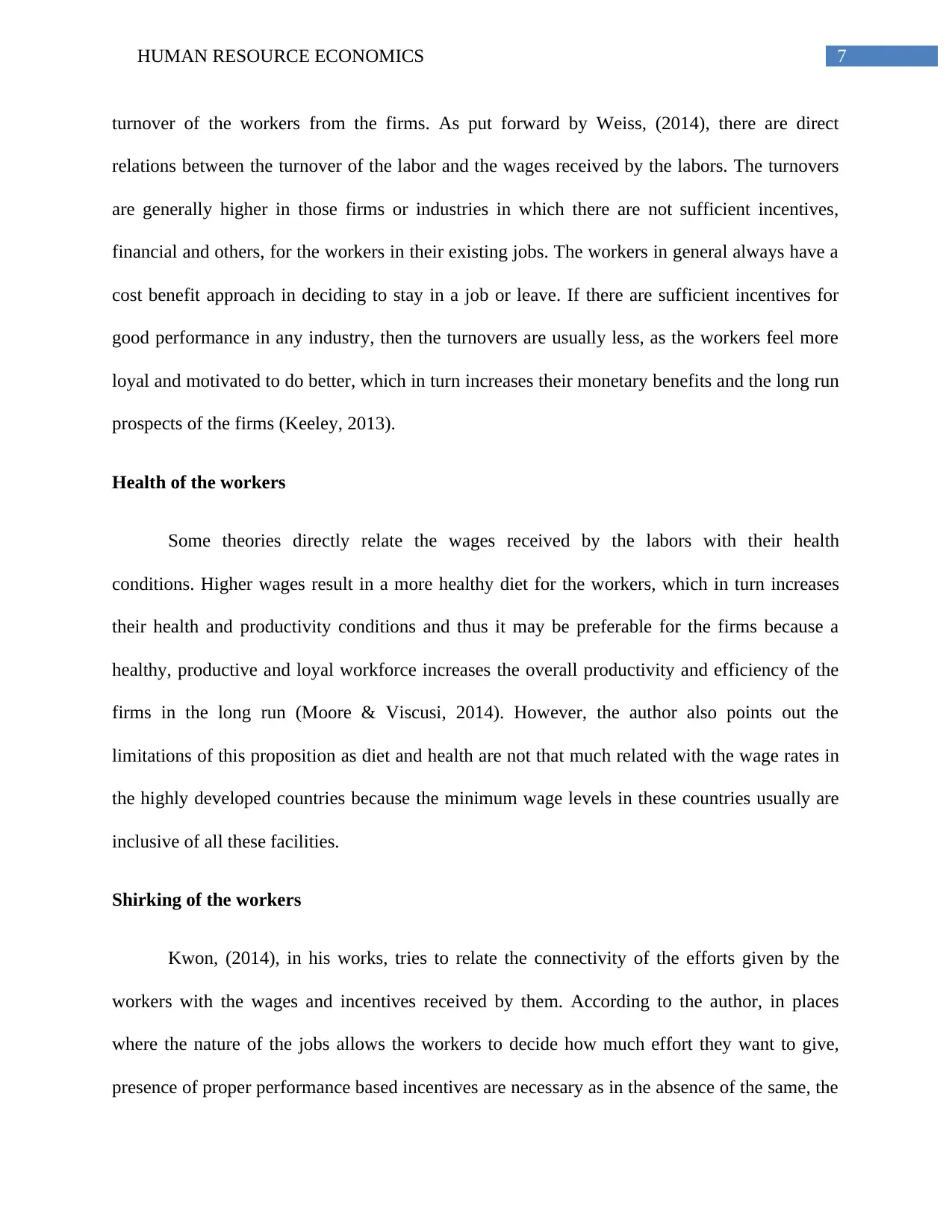
7HUMAN RESOURCE ECONOMICS
turnover of the workers from the firms. As put forward by Weiss, (2014), there are direct
relations between the turnover of the labor and the wages received by the labors. The turnovers
are generally higher in those firms or industries in which there are not sufficient incentives,
financial and others, for the workers in their existing jobs. The workers in general always have a
cost benefit approach in deciding to stay in a job or leave. If there are sufficient incentives for
good performance in any industry, then the turnovers are usually less, as the workers feel more
loyal and motivated to do better, which in turn increases their monetary benefits and the long run
prospects of the firms (Keeley, 2013).
Health of the workers
Some theories directly relate the wages received by the labors with their health
conditions. Higher wages result in a more healthy diet for the workers, which in turn increases
their health and productivity conditions and thus it may be preferable for the firms because a
healthy, productive and loyal workforce increases the overall productivity and efficiency of the
firms in the long run (Moore & Viscusi, 2014). However, the author also points out the
limitations of this proposition as diet and health are not that much related with the wage rates in
the highly developed countries because the minimum wage levels in these countries usually are
inclusive of all these facilities.
Shirking of the workers
Kwon, (2014), in his works, tries to relate the connectivity of the efforts given by the
workers with the wages and incentives received by them. According to the author, in places
where the nature of the jobs allows the workers to decide how much effort they want to give,
presence of proper performance based incentives are necessary as in the absence of the same, the
turnover of the workers from the firms. As put forward by Weiss, (2014), there are direct
relations between the turnover of the labor and the wages received by the labors. The turnovers
are generally higher in those firms or industries in which there are not sufficient incentives,
financial and others, for the workers in their existing jobs. The workers in general always have a
cost benefit approach in deciding to stay in a job or leave. If there are sufficient incentives for
good performance in any industry, then the turnovers are usually less, as the workers feel more
loyal and motivated to do better, which in turn increases their monetary benefits and the long run
prospects of the firms (Keeley, 2013).
Health of the workers
Some theories directly relate the wages received by the labors with their health
conditions. Higher wages result in a more healthy diet for the workers, which in turn increases
their health and productivity conditions and thus it may be preferable for the firms because a
healthy, productive and loyal workforce increases the overall productivity and efficiency of the
firms in the long run (Moore & Viscusi, 2014). However, the author also points out the
limitations of this proposition as diet and health are not that much related with the wage rates in
the highly developed countries because the minimum wage levels in these countries usually are
inclusive of all these facilities.
Shirking of the workers
Kwon, (2014), in his works, tries to relate the connectivity of the efforts given by the
workers with the wages and incentives received by them. According to the author, in places
where the nature of the jobs allows the workers to decide how much effort they want to give,
presence of proper performance based incentives are necessary as in the absence of the same, the
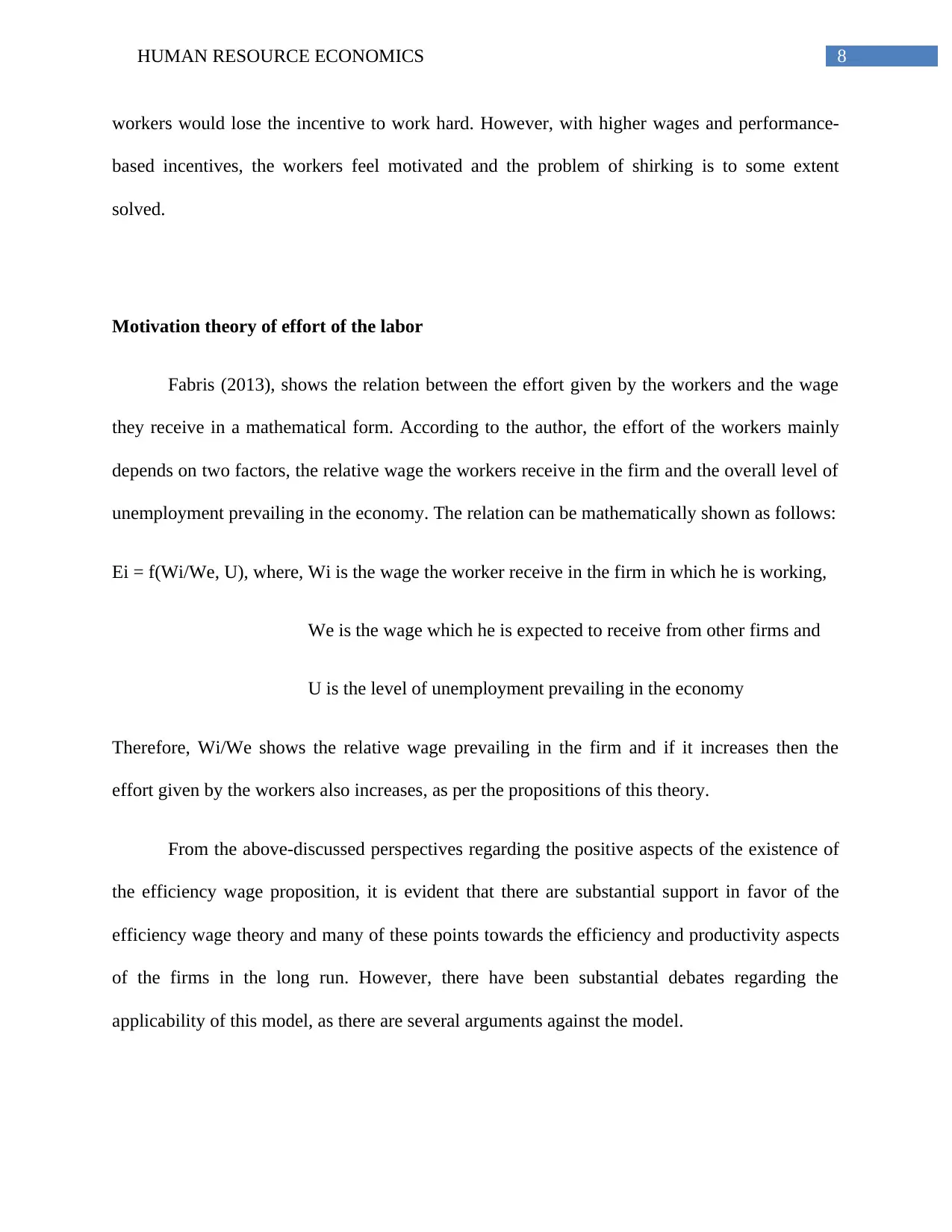
8HUMAN RESOURCE ECONOMICS
workers would lose the incentive to work hard. However, with higher wages and performance-
based incentives, the workers feel motivated and the problem of shirking is to some extent
solved.
Motivation theory of effort of the labor
Fabris (2013), shows the relation between the effort given by the workers and the wage
they receive in a mathematical form. According to the author, the effort of the workers mainly
depends on two factors, the relative wage the workers receive in the firm and the overall level of
unemployment prevailing in the economy. The relation can be mathematically shown as follows:
Ei = f(Wi/We, U), where, Wi is the wage the worker receive in the firm in which he is working,
We is the wage which he is expected to receive from other firms and
U is the level of unemployment prevailing in the economy
Therefore, Wi/We shows the relative wage prevailing in the firm and if it increases then the
effort given by the workers also increases, as per the propositions of this theory.
From the above-discussed perspectives regarding the positive aspects of the existence of
the efficiency wage proposition, it is evident that there are substantial support in favor of the
efficiency wage theory and many of these points towards the efficiency and productivity aspects
of the firms in the long run. However, there have been substantial debates regarding the
applicability of this model, as there are several arguments against the model.
workers would lose the incentive to work hard. However, with higher wages and performance-
based incentives, the workers feel motivated and the problem of shirking is to some extent
solved.
Motivation theory of effort of the labor
Fabris (2013), shows the relation between the effort given by the workers and the wage
they receive in a mathematical form. According to the author, the effort of the workers mainly
depends on two factors, the relative wage the workers receive in the firm and the overall level of
unemployment prevailing in the economy. The relation can be mathematically shown as follows:
Ei = f(Wi/We, U), where, Wi is the wage the worker receive in the firm in which he is working,
We is the wage which he is expected to receive from other firms and
U is the level of unemployment prevailing in the economy
Therefore, Wi/We shows the relative wage prevailing in the firm and if it increases then the
effort given by the workers also increases, as per the propositions of this theory.
From the above-discussed perspectives regarding the positive aspects of the existence of
the efficiency wage proposition, it is evident that there are substantial support in favor of the
efficiency wage theory and many of these points towards the efficiency and productivity aspects
of the firms in the long run. However, there have been substantial debates regarding the
applicability of this model, as there are several arguments against the model.
⊘ This is a preview!⊘
Do you want full access?
Subscribe today to unlock all pages.

Trusted by 1+ million students worldwide
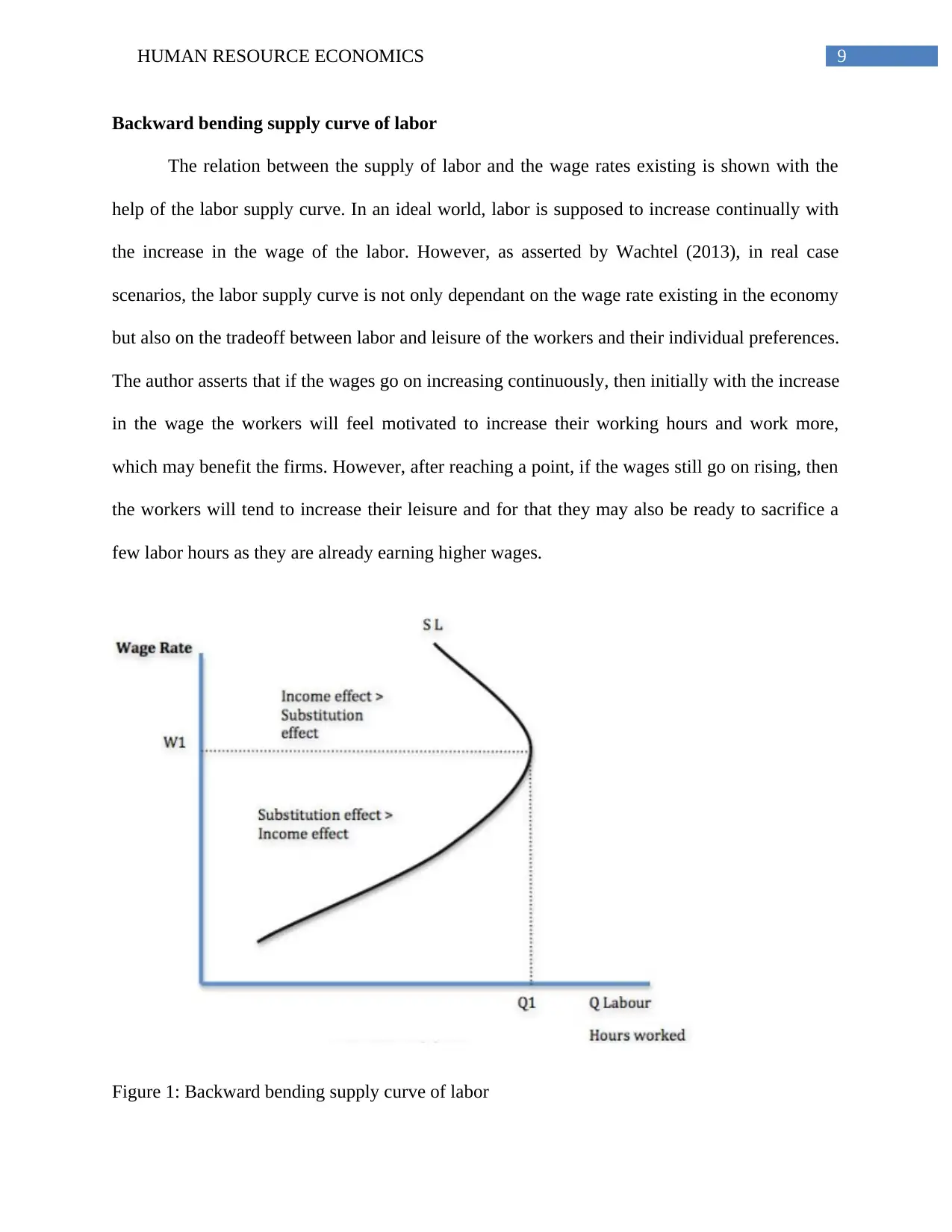
9HUMAN RESOURCE ECONOMICS
Backward bending supply curve of labor
The relation between the supply of labor and the wage rates existing is shown with the
help of the labor supply curve. In an ideal world, labor is supposed to increase continually with
the increase in the wage of the labor. However, as asserted by Wachtel (2013), in real case
scenarios, the labor supply curve is not only dependant on the wage rate existing in the economy
but also on the tradeoff between labor and leisure of the workers and their individual preferences.
The author asserts that if the wages go on increasing continuously, then initially with the increase
in the wage the workers will feel motivated to increase their working hours and work more,
which may benefit the firms. However, after reaching a point, if the wages still go on rising, then
the workers will tend to increase their leisure and for that they may also be ready to sacrifice a
few labor hours as they are already earning higher wages.
Figure 1: Backward bending supply curve of labor
Backward bending supply curve of labor
The relation between the supply of labor and the wage rates existing is shown with the
help of the labor supply curve. In an ideal world, labor is supposed to increase continually with
the increase in the wage of the labor. However, as asserted by Wachtel (2013), in real case
scenarios, the labor supply curve is not only dependant on the wage rate existing in the economy
but also on the tradeoff between labor and leisure of the workers and their individual preferences.
The author asserts that if the wages go on increasing continuously, then initially with the increase
in the wage the workers will feel motivated to increase their working hours and work more,
which may benefit the firms. However, after reaching a point, if the wages still go on rising, then
the workers will tend to increase their leisure and for that they may also be ready to sacrifice a
few labor hours as they are already earning higher wages.
Figure 1: Backward bending supply curve of labor
Paraphrase This Document
Need a fresh take? Get an instant paraphrase of this document with our AI Paraphraser
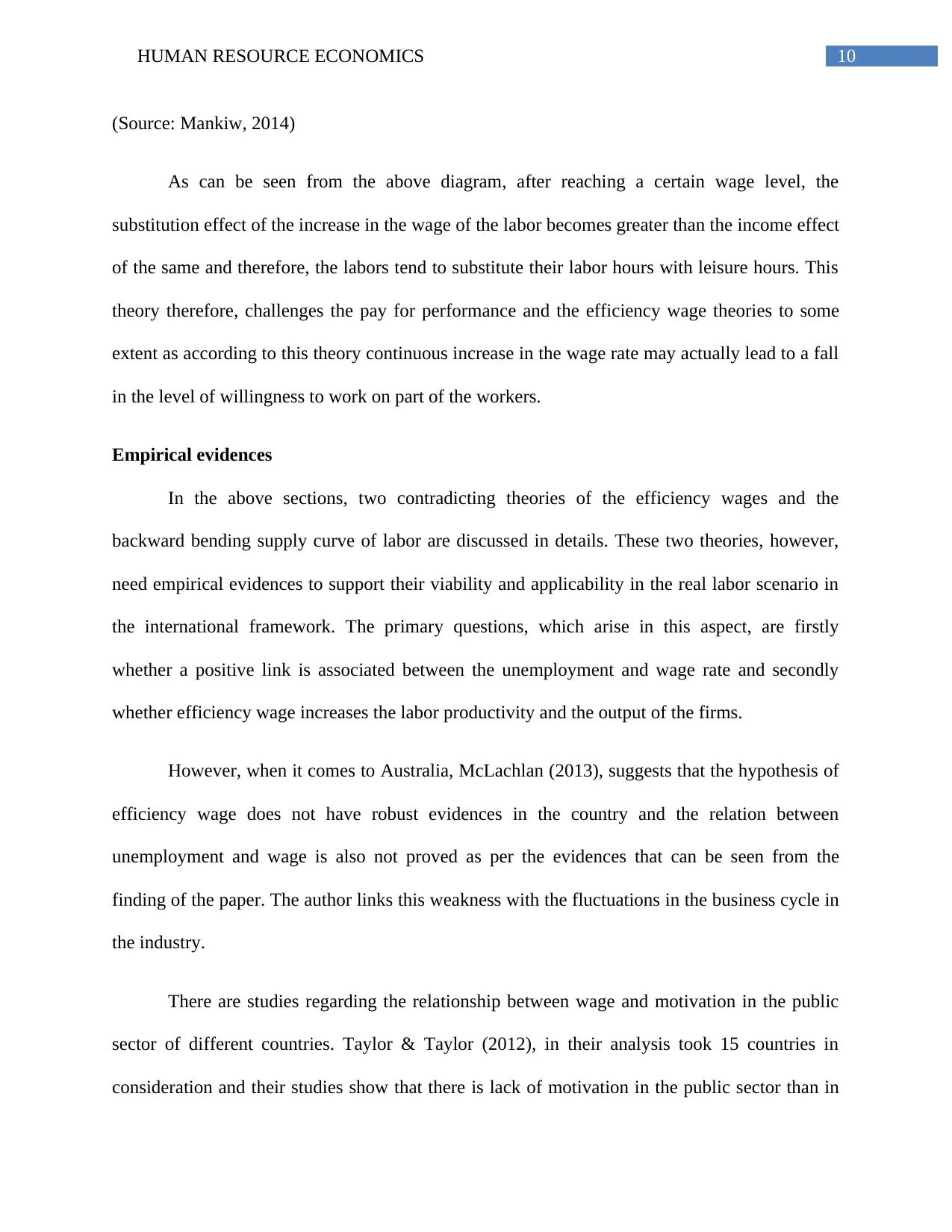
10HUMAN RESOURCE ECONOMICS
(Source: Mankiw, 2014)
As can be seen from the above diagram, after reaching a certain wage level, the
substitution effect of the increase in the wage of the labor becomes greater than the income effect
of the same and therefore, the labors tend to substitute their labor hours with leisure hours. This
theory therefore, challenges the pay for performance and the efficiency wage theories to some
extent as according to this theory continuous increase in the wage rate may actually lead to a fall
in the level of willingness to work on part of the workers.
Empirical evidences
In the above sections, two contradicting theories of the efficiency wages and the
backward bending supply curve of labor are discussed in details. These two theories, however,
need empirical evidences to support their viability and applicability in the real labor scenario in
the international framework. The primary questions, which arise in this aspect, are firstly
whether a positive link is associated between the unemployment and wage rate and secondly
whether efficiency wage increases the labor productivity and the output of the firms.
However, when it comes to Australia, McLachlan (2013), suggests that the hypothesis of
efficiency wage does not have robust evidences in the country and the relation between
unemployment and wage is also not proved as per the evidences that can be seen from the
finding of the paper. The author links this weakness with the fluctuations in the business cycle in
the industry.
There are studies regarding the relationship between wage and motivation in the public
sector of different countries. Taylor & Taylor (2012), in their analysis took 15 countries in
consideration and their studies show that there is lack of motivation in the public sector than in
(Source: Mankiw, 2014)
As can be seen from the above diagram, after reaching a certain wage level, the
substitution effect of the increase in the wage of the labor becomes greater than the income effect
of the same and therefore, the labors tend to substitute their labor hours with leisure hours. This
theory therefore, challenges the pay for performance and the efficiency wage theories to some
extent as according to this theory continuous increase in the wage rate may actually lead to a fall
in the level of willingness to work on part of the workers.
Empirical evidences
In the above sections, two contradicting theories of the efficiency wages and the
backward bending supply curve of labor are discussed in details. These two theories, however,
need empirical evidences to support their viability and applicability in the real labor scenario in
the international framework. The primary questions, which arise in this aspect, are firstly
whether a positive link is associated between the unemployment and wage rate and secondly
whether efficiency wage increases the labor productivity and the output of the firms.
However, when it comes to Australia, McLachlan (2013), suggests that the hypothesis of
efficiency wage does not have robust evidences in the country and the relation between
unemployment and wage is also not proved as per the evidences that can be seen from the
finding of the paper. The author links this weakness with the fluctuations in the business cycle in
the industry.
There are studies regarding the relationship between wage and motivation in the public
sector of different countries. Taylor & Taylor (2012), in their analysis took 15 countries in
consideration and their studies show that there is lack of motivation in the public sector than in
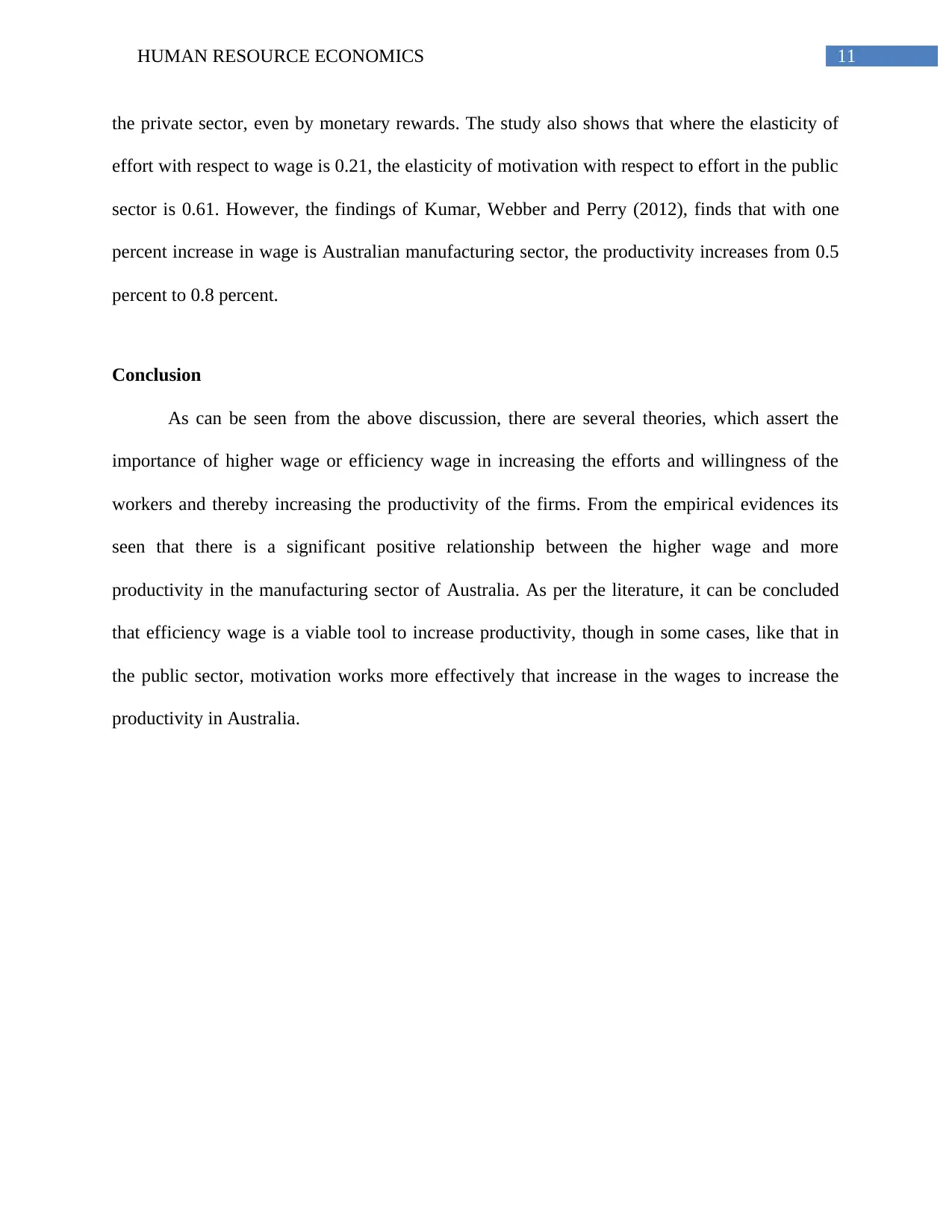
11HUMAN RESOURCE ECONOMICS
the private sector, even by monetary rewards. The study also shows that where the elasticity of
effort with respect to wage is 0.21, the elasticity of motivation with respect to effort in the public
sector is 0.61. However, the findings of Kumar, Webber and Perry (2012), finds that with one
percent increase in wage is Australian manufacturing sector, the productivity increases from 0.5
percent to 0.8 percent.
Conclusion
As can be seen from the above discussion, there are several theories, which assert the
importance of higher wage or efficiency wage in increasing the efforts and willingness of the
workers and thereby increasing the productivity of the firms. From the empirical evidences its
seen that there is a significant positive relationship between the higher wage and more
productivity in the manufacturing sector of Australia. As per the literature, it can be concluded
that efficiency wage is a viable tool to increase productivity, though in some cases, like that in
the public sector, motivation works more effectively that increase in the wages to increase the
productivity in Australia.
the private sector, even by monetary rewards. The study also shows that where the elasticity of
effort with respect to wage is 0.21, the elasticity of motivation with respect to effort in the public
sector is 0.61. However, the findings of Kumar, Webber and Perry (2012), finds that with one
percent increase in wage is Australian manufacturing sector, the productivity increases from 0.5
percent to 0.8 percent.
Conclusion
As can be seen from the above discussion, there are several theories, which assert the
importance of higher wage or efficiency wage in increasing the efforts and willingness of the
workers and thereby increasing the productivity of the firms. From the empirical evidences its
seen that there is a significant positive relationship between the higher wage and more
productivity in the manufacturing sector of Australia. As per the literature, it can be concluded
that efficiency wage is a viable tool to increase productivity, though in some cases, like that in
the public sector, motivation works more effectively that increase in the wages to increase the
productivity in Australia.
⊘ This is a preview!⊘
Do you want full access?
Subscribe today to unlock all pages.

Trusted by 1+ million students worldwide
1 out of 15
Related Documents
Your All-in-One AI-Powered Toolkit for Academic Success.
+13062052269
info@desklib.com
Available 24*7 on WhatsApp / Email
![[object Object]](/_next/static/media/star-bottom.7253800d.svg)
Unlock your academic potential
Copyright © 2020–2025 A2Z Services. All Rights Reserved. Developed and managed by ZUCOL.




